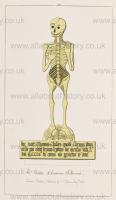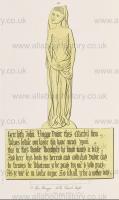Text this colour links to Pages. Text this colour links to Family Trees. Place the mouse over images to see a larger image. Click on paintings to see the painter's Biography Page. Mouse over links for a preview. Move the mouse off the painting or link to close the popup.
Engravings of Sepulchral Brasses is in Victorian Books.

Plate CII. Thomas Leman, at Southacre [Map], 1534.
Blomefield's Norf. vi. 83.
Another bachelor of arts, but with what appears to be a cassock, in addition to his gown. He is to be noticed as being the first without the tonsure. In this year the authority of the Pope in this kingdom was formally renounced by Parliament, to which, perhaps, may be attributed the alteration which from this time took place in the hair of the clergy. He was rector of Southacre thirty-two years.

Plate CVI. Thomas Childes, In St. Lawrence's Church [Map], Norwich, 1452.
Blomefield's Norf. iv. 267.
Though little can be said in favour of the knowledge or execution displayed in these figures, the moral intention is deserving of praise. It was wished to remind men that the robes of pride will shortly be exchanged for the winding-sheet, and that beauty and strength are hastening to the period when they will become as the spectre before them. This species of memorial [Cadaver] appeared in stone effigies, in the preceding century, on the tomb of an ecclesiastic; but that before us is the first I meet with in brass, and it may be considered early; for Gough, i. 112, says, that the oldest figure he knows of a skeleton in brass, is A. D. 1471. Of Thomas Childes himself, I find nothing more than is mentioned in the epitaph.

Plate CVIII. John Brigge (deceased), at Salle [Map], 1454.
Blomefield's Norf. iv. 216.
This person was the descendant of an ancient family at Salle, who, before the time of Edward I. assumed the surname of De Ponte or Pontibus, 7. e. at Brigge or at Brigges, as the ancient family of the Fountains of the same place assumed theirs of De Fonte or Fontibus, at the Fountain or Fountains, much about the same time ; the one dwelling by the spring, and the other by the bridge over the current that flowed from it: the eldest branches of both families continued at Salle till they united in one, in the middle of the sixteenth century. (Vid. Blomef. loc. sup. cit.)
John Brigge of Salle: Before 1454 he was born to John Atte Brigge. In 1481 he died.